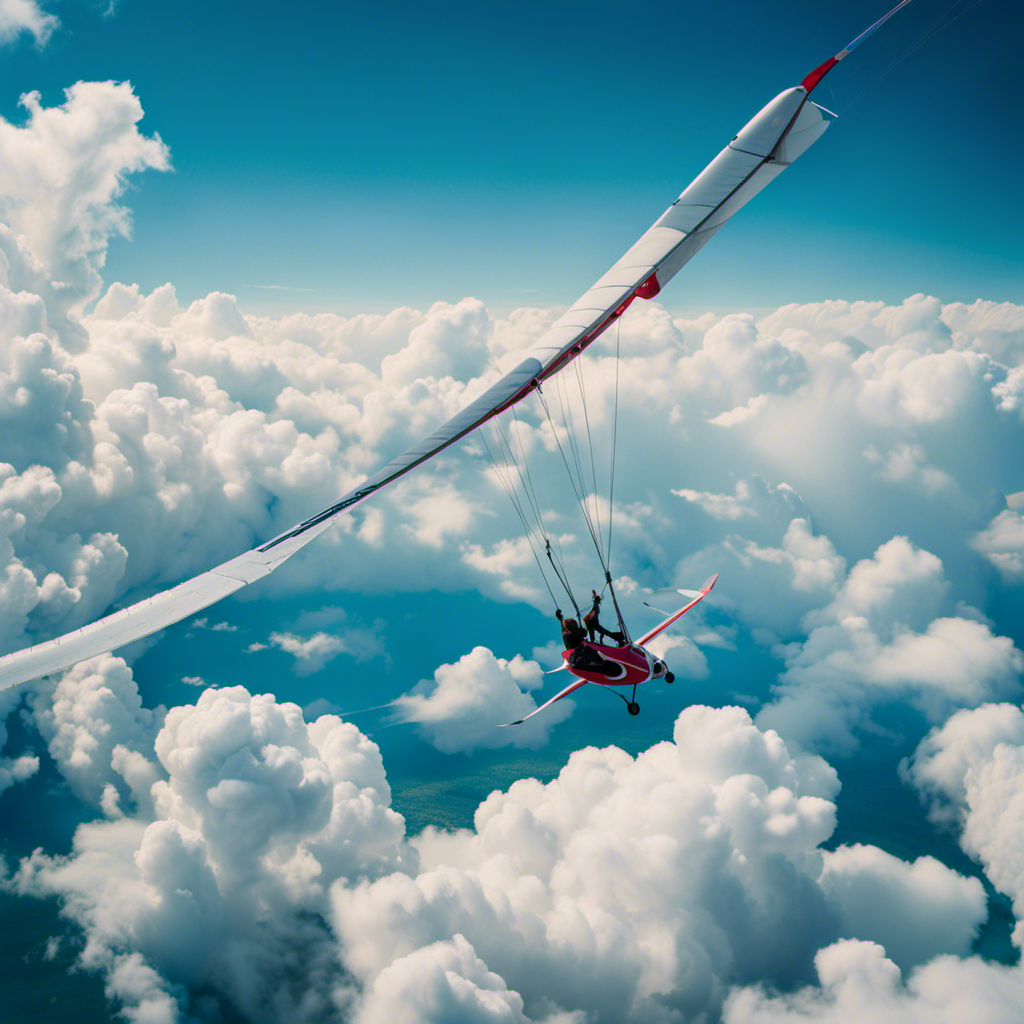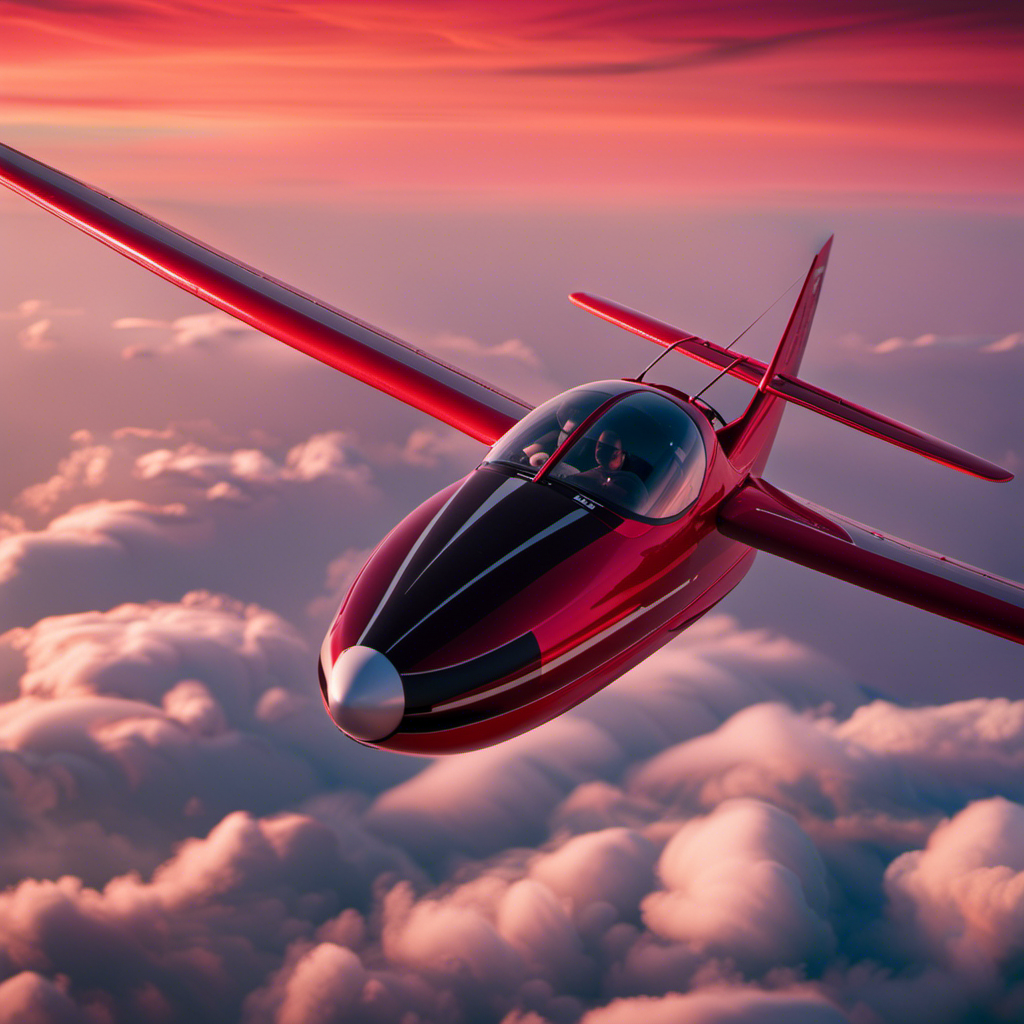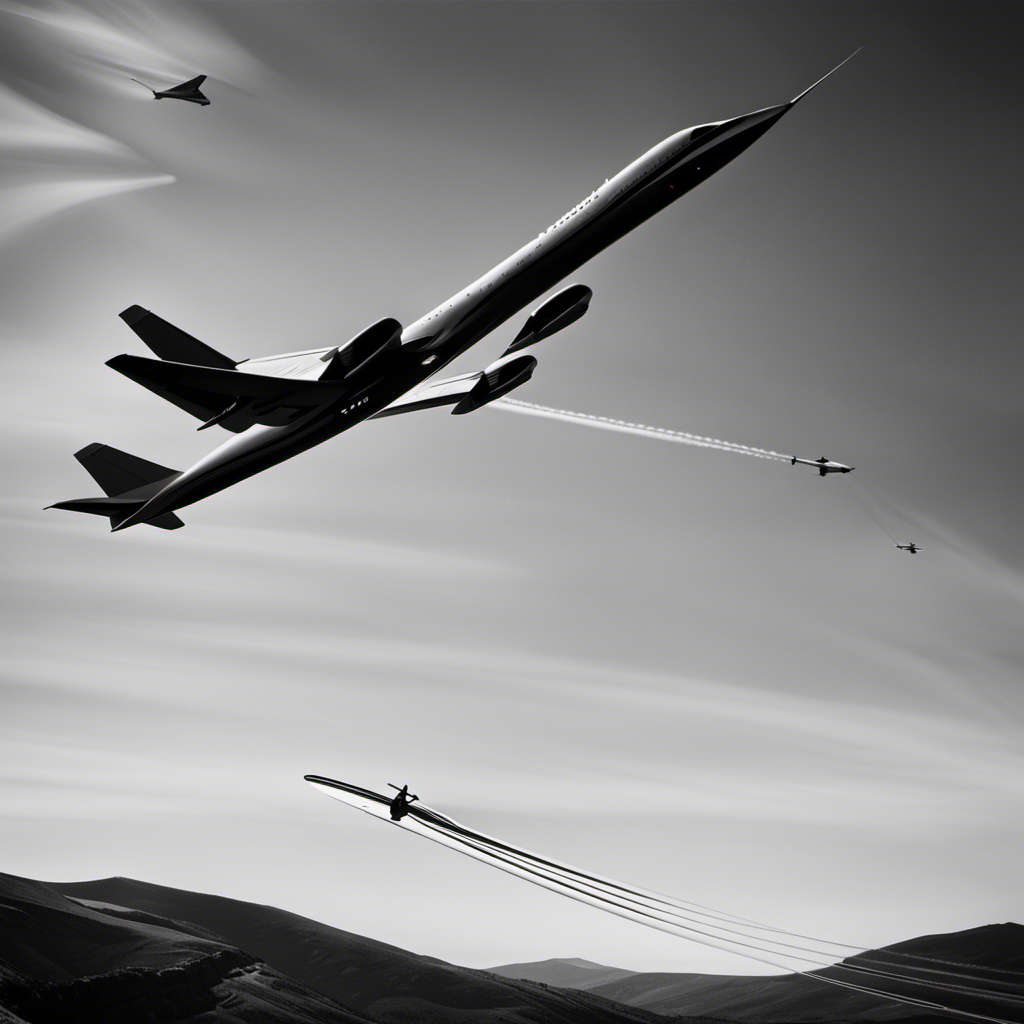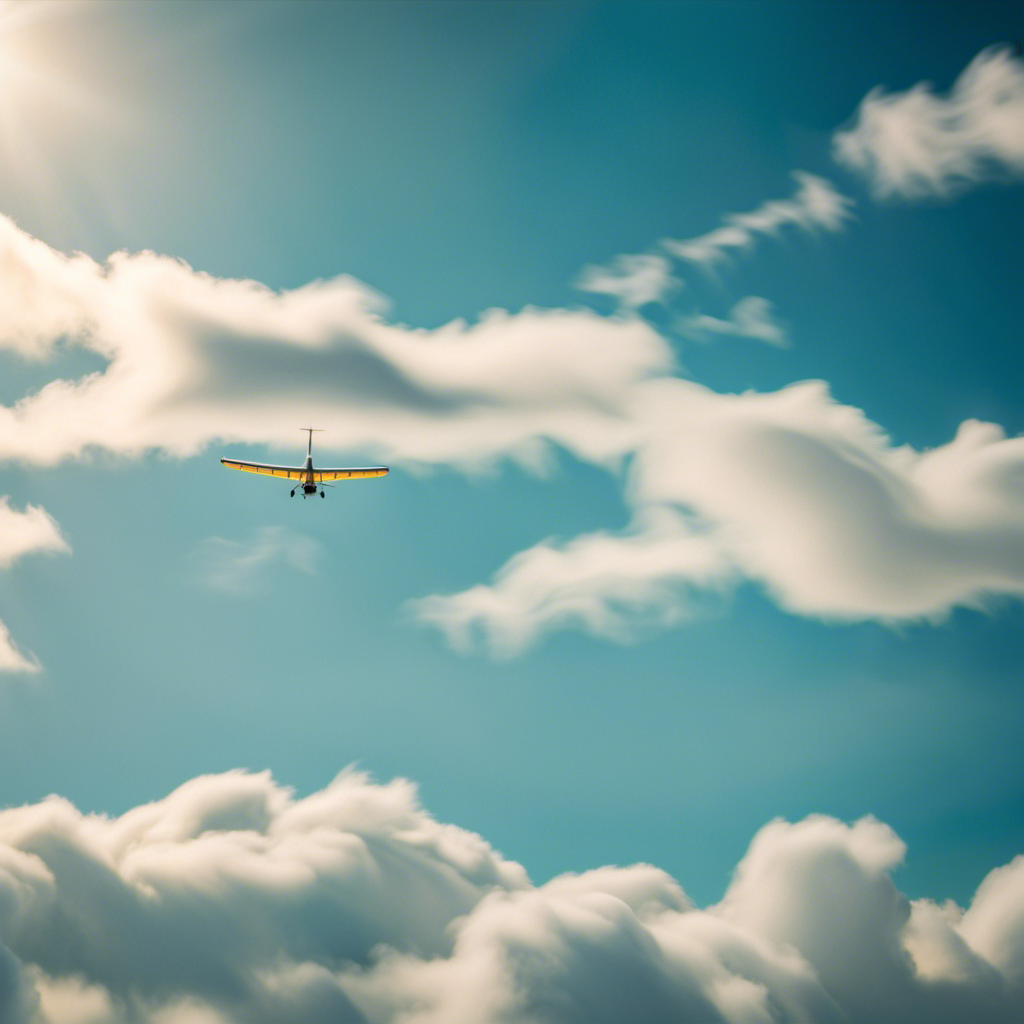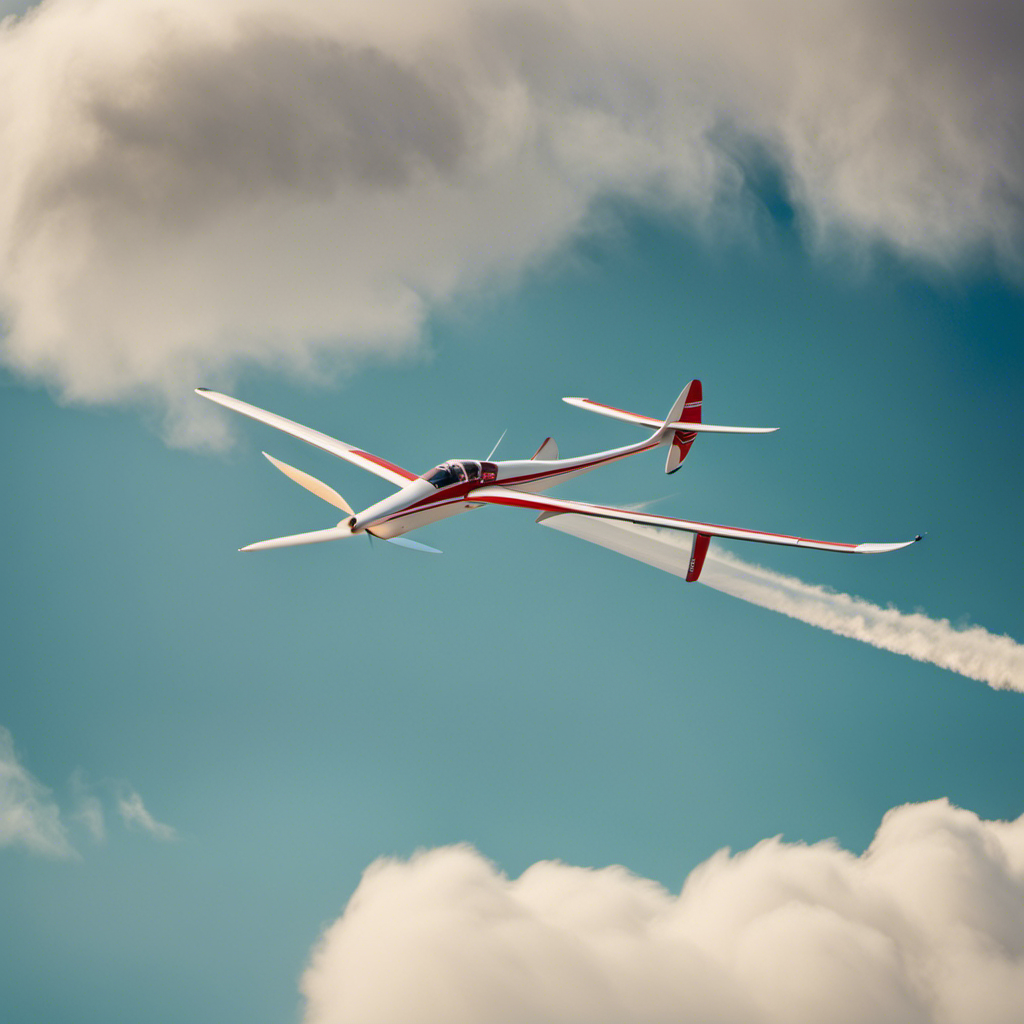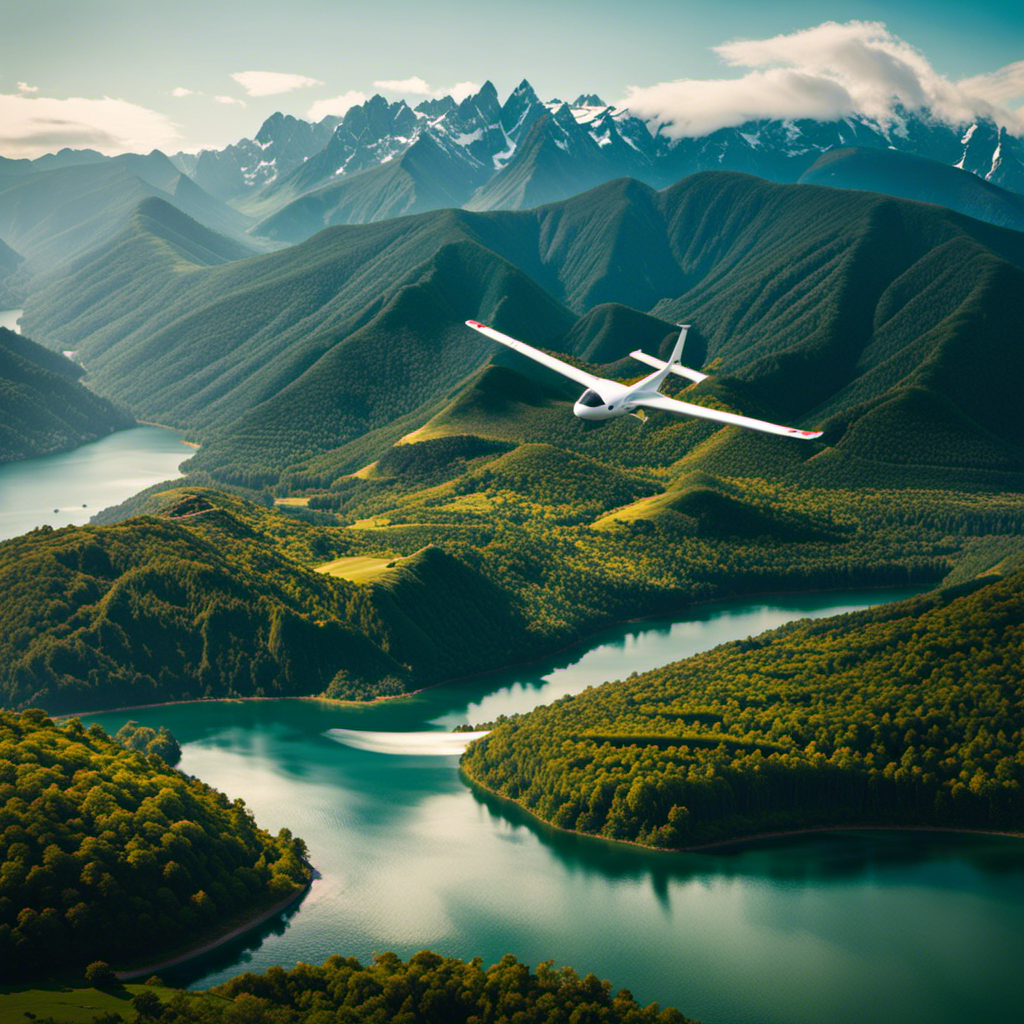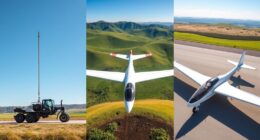Imagine yourself soaring through the sky, feeling the rush of wind against your face, and reveling in the pure exhilaration of flying, just like a bird.
In this step-by-step guide, I’ll take you on a journey to master the art of flying a glider.
From understanding the basics to navigating and mastering maneuvers, we’ll cover it all.
So, buckle up and get ready to embark on a thrilling adventure that will leave you craving the joy of gliding over and over again.
Key Takeaways
- Understanding gliders and their components through online tutorials, videos, books, and manuals is essential for preparing for flight.
- Conducting regular inspections and maintenance is crucial for safety and optimal glider performance.
- Choosing the right glider based on weight, experience level, and preferences is important for a successful flight.
- Gaining altitude by finding thermals, observing wind direction, and studying cloud formations is necessary for glider flight.
Understanding the Basics of Gliders
Understanding the basics of gliders is essential for learning how to fly them. Before you can take to the skies, it is important to have a solid understanding of the mechanics and maintenance involved with these aircraft.
To begin your journey, there are a variety of learning resources available to help you grasp the fundamentals.
Firstly, there are many online tutorials and videos that can provide a comprehensive overview of gliders and their components. These resources can help you familiarize yourself with the different parts of a glider, such as the wings, fuselage, and controls. Additionally, there are instructional books and manuals that can guide you through the intricacies of glider flight.
In addition to learning the theory, it is crucial to understand the importance of glider maintenance. Regular inspections and upkeep are essential for ensuring the safety and optimal performance of your glider. Learning how to inspect and maintain the aircraft properly will help you identify any potential issues before they become major problems.
Preparing for Your Flight
When preparing for a flight, it’s crucial to choose the right glider that suits your flying needs and experience level.
Conducting pre-flight inspections is essential to ensure the glider is in optimal condition and safe to fly.
Additionally, taking the time to familiarize yourself with the controls of the glider is necessary to ensure a smooth and controlled flight.
Choosing the Right Glider
To make sure you choose the right glider, consider factors such as your weight, experience level, and personal preferences.
When it comes to choosing the right glider, there are a few key things to keep in mind.
First, consider your weight. Each glider has a weight limit, and exceeding it can compromise safety and performance.
Next, think about your experience level. Beginners should opt for a glider with stable and forgiving flight characteristics, while more experienced pilots may prefer a high-performance glider.
Finally, consider your personal preferences in terms of handling, speed, and maneuverability.
Once you’ve chosen the right glider, it’s important to stay on top of glider maintenance. Regular inspections and necessary repairs will ensure your glider remains in optimal condition for safe and enjoyable flights.
Now, let’s move on to pre-flight inspections, where we’ll cover the essential checks before taking to the skies.
Pre-Flight Inspections
Before taking off, you’ll need to perform a thorough pre-flight inspection to ensure the safety of your glider. This is a critical step in the flying process, as it allows you to identify any potential issues before they become a problem in the air.
To begin, refer to your pre-flight checklist, which will outline all the areas you need to examine. Start by visually inspecting the entire glider, looking for any signs of damage or wear. Check the control surfaces, such as the ailerons and elevators, to ensure they move freely and are securely attached. Inspect the wing, paying close attention to the leading edge for any dents or cracks.
Once you have thoroughly examined the glider, you can move on to getting familiar with the controls without delay.
Getting Familiar with the Controls
Once you’ve completed your pre-flight inspection, it’s time to get familiar with the controls. Here are three key steps to help you get comfortable and master controlling the glider:
-
Sit in the cockpit: Adjust the seat and harness to ensure a secure and comfortable fit. Familiarize yourself with the instrument panel and locate the important controls such as the stick or yoke, rudder pedals, and airbrakes.
-
Understand the primary controls: The stick or yoke controls the pitch, allowing you to control the glider’s nose-up and nose-down movements. The rudder pedals control the yaw, enabling you to turn left or right. The airbrakes help you control the glider’s descent rate.
-
Practice the movements: Start by gently moving the stick and pedals to get a feel for how the glider responds. Gradually increase your control inputs to understand the glider’s handling characteristics.
Once you have a good understanding of the controls and feel comfortable, you’re ready to move on to taking off smoothly without any hesitation.
Taking Off
When it comes to launching a glider, there are several methods to choose from: aerotow, winch, and self-launch. Each method has its own advantages and considerations.
Once in the air, executing a smooth takeoff is crucial for a successful flight. Gaining altitude and finding thermals are also key points to focus on, as they will determine how long and far you can stay in the air.
Launching Methods (Aerotow, Winch, Self-Launch)
To launch a glider, you can use various methods such as aerotow, winch, or self-launch. Aerotow involves a powered aircraft towing the glider into the air using a long rope. This method allows for higher altitudes and longer flights, but it requires a second pilot and can be more expensive.
On the other hand, winch launching involves a stationary winch pulling the glider into the air using a cable. This method is cost-effective and doesn’t require a second pilot, but it has limitations in terms of altitude and flight duration.
Self-launch, as the name suggests, allows the glider to launch itself using an engine. This method offers the most flexibility, but it requires additional equipment and maintenance.
Transitioning into executing a smooth takeoff, it is crucial to maintain control and ensure a safe ascent.
Executing a Smooth Takeoff
After mastering the different launching methods, it’s time to focus on executing a smooth takeoff in a glider. As a pilot, it is crucial to ensure a safe and controlled ascent.
To achieve this, I begin by positioning the glider correctly on the runway, aligning it with the wind direction. I then smoothly apply full throttle, gradually increasing the airspeed. As the glider gains momentum, I maintain a steady pitch attitude to prevent the nose from rising too quickly.
Once the glider reaches the desired takeoff speed, I gently pull back on the control stick to lift off the ground. Throughout the takeoff, I constantly monitor and adjust the airspeed, ensuring it remains within the recommended range for a smooth and controlled ascent.
Now, let’s explore the next phase of flying – gaining altitude and finding thermals.
Gaining Altitude and Finding Thermals
As a pilot, I can gain altitude and find thermals by constantly scanning the sky for signs of rising warm air. Here are some key strategies for finding lift and maximizing glide:
- Look for cumulus clouds, as they often indicate the presence of thermals.
- Pay attention to the wind direction and speed, as this can help you identify areas where thermals are more likely to form.
- Observe the behavior of birds, as they are skilled at finding lift and can guide you towards thermals.
By utilizing these techniques, I can efficiently navigate the sky and make the most of the available lift. This allows me to gain altitude and extend my flight time, ultimately enhancing my overall soaring experience.
Now, let’s delve into the various soaring techniques that further optimize our gliding performance.
Soaring Techniques
Using proper soaring techniques, you can maximize the lift and stay aloft in a glider. These techniques, combined with advanced maneuvers, allow pilots to navigate the skies with precision and efficiency. Here are some essential soaring techniques that every glider pilot should master:
| Technique | Description |
|---|---|
| Thermalling | Flying in circles within a thermal to gain altitude and maintain height. |
| Ridge Soaring | Utilizing wind that hits a ridge or hill to generate lift and stay airborne. |
| Wave Riding | Riding on waves of air generated by strong winds interacting with mountain ranges. |
| Cloud Streets | Following lines of cumulus clouds, which indicate areas of rising air and potential lift. |
| Convergence Zones | Flying to the point where two air masses with different temperatures meet, creating lift. |
Mastering these techniques requires practice and experience. By understanding the principles of lift and using these techniques strategically, pilots can extend their flights and explore new horizons. Once you have mastered soaring techniques, the next step is to focus on navigation and flight planning. This involves understanding weather patterns, plotting routes, and making informed decisions to optimize your flight. By combining soaring techniques with effective navigation and flight planning, you can unlock the full potential of glider flying and experience the freedom of soaring through the sky.
Navigation and Flight Planning
To optimize your flight, focus on understanding weather patterns, plotting routes, and making informed decisions through effective navigation and flight planning.
Navigation techniques play a crucial role in ensuring a smooth and efficient glider flight. By utilizing these techniques, you can optimize your flight route and make the most of the prevailing weather conditions. Before setting off, it is important to study weather forecasts and identify areas with favorable thermals and wind patterns. This knowledge will help you plot a route that maximizes lift and minimizes time spent in sink.
During the flight, effective navigation becomes paramount. By constantly monitoring your position relative to landmarks and waypoints, you can make timely adjustments to stay on course. Flight planning software and instruments such as GPS and altimeters are valuable tools to assist in this process.
By combining weather knowledge, route planning, and effective navigation, you can optimize your flight route and increase your chances of success.
Transitioning to the next section, safety and emergency procedures are equally important in ensuring a safe and enjoyable glider flight.
Safety and Emergency Procedures
Make sure you familiarize yourself with the safety and emergency procedures to ensure a safe and enjoyable glider flight experience. In the event of an emergency landing, it is crucial to know how to handle the situation calmly and effectively.
Before takeoff, the pilot should conduct a thorough pre-flight inspection of the glider, ensuring that all emergency equipment is present and in working order. This includes items such as a fire extinguisher, first aid kit, and emergency locator beacon. Additionally, it is essential to know the location and operation of emergency exits and how to evacuate the glider quickly if necessary.
During the flight, it is important to remain vigilant and constantly assess the conditions and surroundings for any potential emergencies. This includes monitoring weather conditions, traffic, and the glider’s performance. If an emergency situation arises, such as a loss of control or equipment failure, the pilot should follow the emergency procedures outlined in the glider’s operating manual. These procedures may include actions such as initiating an emergency landing, activating emergency equipment, or communicating with air traffic control for assistance.
Mastering Glider Maneuvers
Now that you have familiarized yourself with the safety and emergency procedures, let’s dive into mastering glider maneuvers. As you progress in your glider flying journey, it is important to focus on mastering advanced maneuvers and perfecting landing techniques. These skills will not only enhance your flying experience but also ensure your safety and the safety of those around you.
To help you understand and practice these maneuvers, I have provided a table below outlining three essential glider maneuvers and their key elements:
| Maneuver | Key Elements |
|---|---|
| Spiral Dive | Steep bank angle, controlled descent, coordinated rudder input |
| Thermal Soaring | Identifying thermals, circling within thermal, maintaining altitude |
| Spot Landing | Precise approach, correct speed management, smooth touchdown |
By focusing on these maneuvers, you will gain a deeper understanding of the glider’s capabilities and become more proficient in handling various flight situations. Remember, practice is key when it comes to mastering these maneuvers. The more you practice, the more comfortable and confident you will become.
Now, let’s transition into the next section where we will discuss building experience and skill through continuous learning and flight experience.
Building Experience and Skill
As a glider pilot, I understand the importance of building experience and skill in order to become a proficient and confident flyer. There are three key points that are crucial in this process:
-
Logging flight hours: By carefully tracking my flight hours, I can accurately measure my progress and identify areas for improvement.
-
Participating in glider competitions: This allows me to test my skills against other pilots and learn from their techniques.
-
Continuing education and training: This ensures that I stay updated with the latest advancements in glider technology and safety practices, enabling me to continuously improve my abilities as a pilot.
Logging Flight Hours
You’ll want to start logging your flight hours as soon as you begin your glider training. Keeping a detailed flight log is crucial for tracking your progress and ensuring you meet the necessary requirements for certification. Here’s a sample flight log table that you can use to record your flights:
| Date | Duration (hrs) | Takeoff Location |
|---|---|---|
| 2021-07-01 | 1.5 | ABC Gliderport |
| 2021-07-05 | 2.0 | XYZ Glider Club |
| 2021-07-08 | 1.2 | DEF Airfield |
In your flight log, make sure to include the date, duration of the flight in hours, and the location of takeoff. This will provide valuable information for reviewing your progress and identifying areas for improvement. As you accumulate more flight hours, you’ll gain experience and confidence, preparing you for the next stage of your glider journey: participating in glider competitions.
Participating in Glider Competitions
To compete in glider competitions, it’s important to familiarize yourself with the rules and regulations of the specific event you plan to participate in. Glider competition strategies vary depending on the type of competition, but generally, pilots aim to fly efficiently, maintain altitude, and complete tasks accurately within specific time limits.
Scoring and judging criteria are crucial aspects of glider competitions. Judges evaluate factors such as flight duration, distance covered, and completion of specific maneuvers. Additionally, pilots may receive bonus points for achieving specific goals or flying in challenging conditions. Understanding these criteria is essential for developing successful competition strategies.
Continuing Education and Training
To further improve your skills and stay up-to-date with the latest gliding techniques, it’s important to actively pursue continuing education and training opportunities.
Engaging in continuing education allows you to expand your knowledge and push the boundaries of your abilities in the gliding world. Advanced training programs provide a platform to learn new maneuvers, enhance your understanding of aerodynamics, and gain proficiency in navigation systems.
These opportunities often include workshops, seminars, and practical sessions conducted by experienced glider pilots and instructors. By participating in continuing education and advanced training, you can refine your flying skills and become a more competent glider pilot.
This continuous learning process will enable you to confidently navigate challenging flying conditions and make informed decisions while in the air.
As you progress in your gliding journey, joining the gliding community will offer you a platform to connect with fellow enthusiasts, share experiences, and learn from seasoned pilots.
Joining the Gliding Community
Joining the gliding community can be a great way to connect with fellow enthusiasts and learn from experienced pilots. When I first became interested in gliding, I was eager to find a gliding club in my area. Luckily, there are many resources available online that can help you locate gliding clubs near you. These clubs offer a wealth of knowledge and support for new pilots, and often hold regular gliding community events where you can meet other glider enthusiasts and expand your network.
To give you an idea of the types of events you can expect to find in the gliding community, here’s a table showcasing some common examples:
| Event | Description |
|---|---|
| Glider Competitions | Competitive events where pilots showcase their skills and compete against each other. |
| Gliding Workshops | Educational sessions where experienced pilots share their expertise and teach new techniques. |
| Fly-ins | Gatherings where glider pilots from different clubs come together to fly and socialize. |
| Cross-Country Flights | Planned flights where pilots navigate long distances, often reaching new destinations. |
| Gliding Expos | Exhibitions where gliding clubs and manufacturers showcase the latest advancements in the industry. |
Embracing the Joy of Gliding
By fully immersing yourself in the gliding community, you can embrace the joy of soaring through the sky. One of the first steps in embracing this joy is finding the perfect gliding location. Look for an area with open fields, gentle slopes, and suitable wind conditions. Airports or gliding clubs can provide valuable information about such locations.
Once you have found the ideal spot, it’s time to overcome any fear of heights you may have. This fear is common but can be conquered through gradual exposure and practice. Start by visiting the gliding site and observing other pilots in action. Familiarize yourself with the glider and its controls, and ask experienced pilots to share their knowledge and experiences.
As you gain confidence, take small steps like sitting in the glider and gradually progressing to short glides. Remember that gliding is a thrilling and safe activity, and with proper guidance and practice, you will be able to fully embrace the joy and freedom of gliding through the sky.
Frequently Asked Questions
What is the maximum altitude a glider can reach?
The maximum altitude a glider can reach is determined by various factors, including weather conditions. It is crucial to consider wind patterns, thermals, and cloud formations to optimize the glider’s performance and achieve higher altitudes.
How long does it take to become a certified glider pilot?
Becoming a certified glider pilot requires completing glider pilot training, which involves meeting specific requirements. The duration of training varies, but it typically takes several months to gain the necessary skills and knowledge for certification.
Can gliders fly in bad weather conditions?
Yes, gliders can fly in bad weather conditions, but it presents flying challenges. Safety precautions, such as monitoring weather forecasts, maintaining proper altitude, and being prepared for turbulence, are essential to ensure safe flying.
Are there any age restrictions for flying a glider?
There are age restrictions for flying a glider to ensure safety. Proper training and certification are required, and the minimum age varies by country. Safety measures like pre-flight inspections and following regulations are crucial for glider flying.
What is the average cost of owning and maintaining a glider?
The average cost of owning and maintaining a glider includes expenses for glider insurance and glider storage options. It is important to factor in these costs when budgeting for your glider ownership.
Conclusion
In conclusion, flying a glider is an exhilarating experience that requires knowledge, skill, and practice. By understanding the basics, preparing for your flight, and mastering glider maneuvers, you can become a confident and skilled glider pilot.
One example of the joy of gliding is the story of Sarah, a novice pilot who, after months of training, successfully completed her first solo flight. Her excitement and sense of accomplishment were palpable as she landed smoothly and proudly joined the gliding community.
So why not embark on your own gliding adventure and discover the freedom of soaring through the sky?
